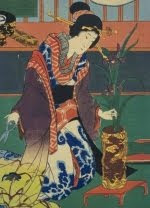While early Land Art had a focus on earthwork making use of soil, rocks etc., ikebana has through it's long history always been based on the nature of plant materials. That is until Sofu Teshigahara, founder of the Sogetsu School, stated that although flowers have been the obvious choice of material in this art of flower arranging, the arranging activity is in fact more important than the materials used.
Robert Smithson is probably the most well known earthwork artist. His Spiral Jetty from 1970 has become iconic. In my opinion his Broken circle created for the Sonsbeek'71 art festival at Emmen, the Netherlands, is even more interesting as a reference for ikebana practitioners.
All ikebana is sensitive to the setting it is going to work within, in that sense it is always site specific and a suitable companion for Land Art. In the same text from 1966 Sofu explains:
I'll discuss ikebana and sculptures placed in an outdoor environment in a later blog post. For now I'll limit myself to present a couple of site spesific sculptures - works that are more closely related to their natural outdoor surroundings.
"Somebody once asked me what I would do if I lived in a place like Manchuria where there are no flowers or plants, to which I replies that I should probably arrange the earth. ... While naturally I consider it fortunate if one has flowers which one can arrange, I do not say that if one lives in a place where there are no flowers it is necessary to grow them at all costs in order to produce ikebana. It should be remembered that the term ikebana is made up of two words; ikeru, which means to arrange or create, and hana, meaning flowers, and that if the two, ikeru is the more important."Sofu was very much influenced by modern Western art. I wouldn't say that Land Art is an important reference for his work, but in this quotation from 1966 the basic idea of rearranging landscape comes through. The Land Art movement started in 1968, so it's the same time period and it's possible that Sofu also referred to the new ideas amongst young Western artists that a couple of years later were to be the basis for the a more organized art movement. It could also be an influence from Japanese American artist Isamu Noguchi who Sofu regarded as a friend and also collaborated with. Noguchi's 1941 design for Contoured Playground in New York is considered an important early piece of land art even though Noguchi himself simply called it "sculpture".
Robert Smithson is probably the most well known earthwork artist. His Spiral Jetty from 1970 has become iconic. In my opinion his Broken circle created for the Sonsbeek'71 art festival at Emmen, the Netherlands, is even more interesting as a reference for ikebana practitioners.
 |
| Robert Smithson: Broken circle, 1970 |
"Whenever I go about producing a floral arrangement, my first consideration is the setting. My aim is always to arrange those materials that I have in such a way that they will fit harmoniously with their surroundings."I've already stated that Sofu doesn't seem to be very occupied by Land Art in a more precise understanding of the category. He opens up the ikebana tradition and in that sense he lays a ground for later ikebana artists, but he never makes use of his idea to arrange the earth - after all he lives in a country where there are flowers available. There are however a few works amongst his drift wood sculptures that can be considered Land Art.
I'll discuss ikebana and sculptures placed in an outdoor environment in a later blog post. For now I'll limit myself to present a couple of site spesific sculptures - works that are more closely related to their natural outdoor surroundings.
 |
| Sofu Teshigahara: Instant sculpture, Lake Shikotsu, Hokkaido. |
 |
| Sofu Teshigahara: Orochi from the Kojiki series 1965/66. Photo: www.sogetsu.or.jp |
For a discussion of definitions and categories in Land Art I recommend this web article by Dutch artist Lucien den Arend.
Quotations and the first photo of works by Sofu can be found in the book:
Sofu: His Boundless World of Flowers and Form
By Sofu Teshigahara with photographs by Ken Domon
Published by Kodansha International, Tokyo / Palo Alto, California 1966












No comments:
Post a Comment